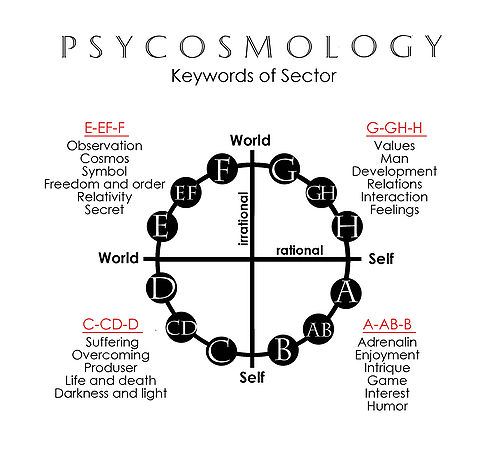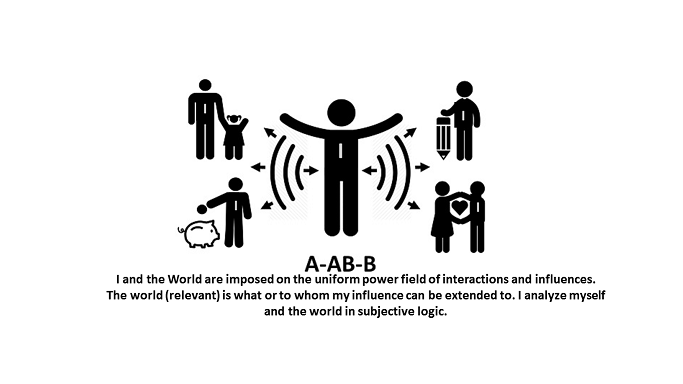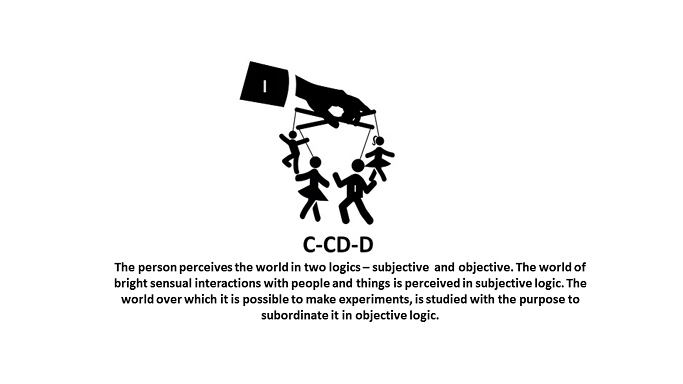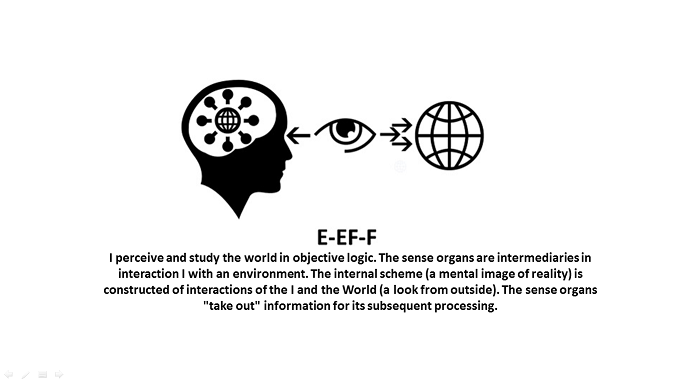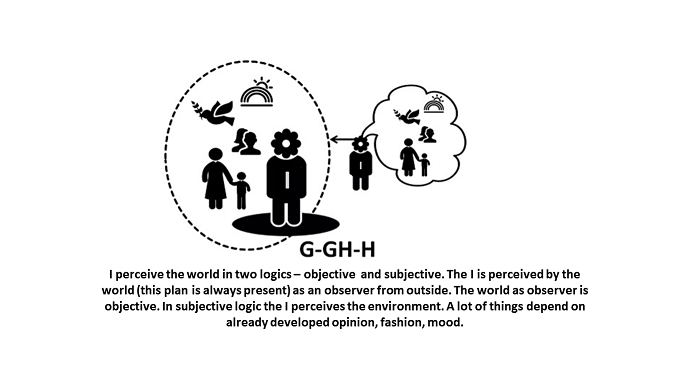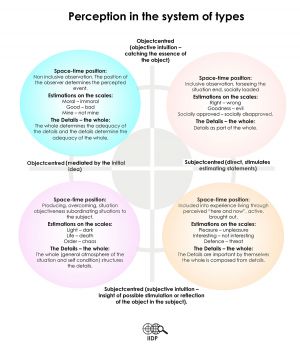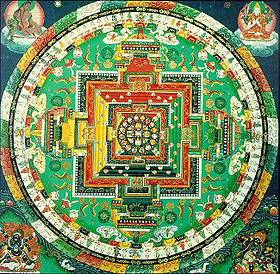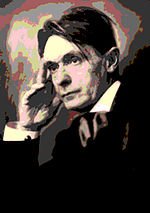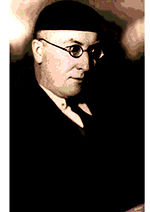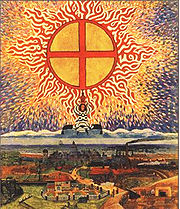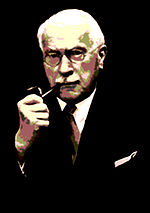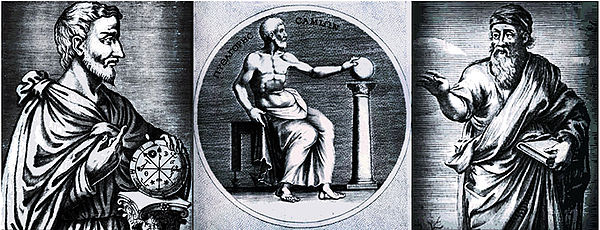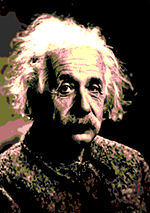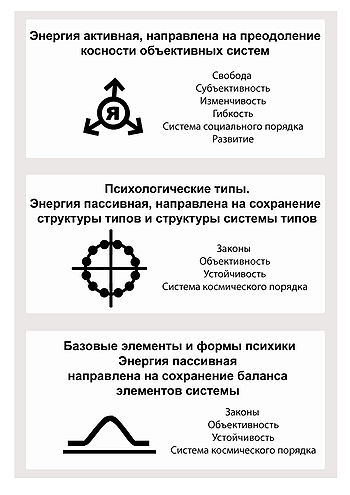Psycosmology: различия между версиями
Nagibina (обсуждение | вклад) |
Nagibina (обсуждение | вклад) |
||
| Строка 22: | Строка 22: | ||
| − | The psychological type (in psycosmology) is the type of man psychic, which is determined by the correlations and directness of consciousness (rational) and unconsciousness (irrational) cognition of man. The psychotype causes the dominating in the psychic was of getting and processing information, the possibilities of man in interaction with the environment, his/her strong and weak sides. All together 12 types are established and considered in psycosmology. These types are distinguished by the preference and orientation of conscious and unconscious cognition. | + | The psychological type (in psycosmology) is the type of man psychic, which is determined by the correlations and directness of consciousness (rational) and unconsciousness (irrational) cognition of man. The psychotype causes the dominating in the psychic was of getting and processing information, the possibilities of man in interaction with the environment, his/her strong and weak sides. All together 12 types are established and considered in psycosmology. These types are distinguished by the preference and orientation of conscious and unconscious cognition. |
| − | + | ||
| + | |||
| + | == Set of cognition == | ||
| + | |||
| + | Set of cognition (in a psycosmology) is an orientation of the conscious (rational) and unconscious (irrational) cognition of the person. | ||
| + | |||
| + | Quadrants of system correspond to four types of orientation: | ||
| + | |||
| + | ''The lower right quadrant'' – subjekt-centerred (subject-oriented) set of both conscious and unconscious cognition. | ||
| + | |||
| + | [[Файл:a-b.png]] | ||
| + | |||
| + | ''The lower left quadrant'' - subjekt-centerred (subject-oriented) set of unconscious cognition and object centerred (object-oriented) set of conscious cognition. | ||
| + | |||
| + | [[Файл:c-d.png]] | ||
| + | |||
| + | ''The top left quadrant'' - objekt-centerred (object-oriented) set of both conscious and unconscious cognition. | ||
| + | |||
| + | [[Файл:e-f.png]] | ||
| + | |||
| + | ''The top right quadrant'' - objekt-centerred (object-oriented) set of unconscious cognition and subject-centerred (subject-oriented) set of conscious cognition. | ||
| + | |||
| + | [[Файл:g-h.png]] | ||
== Model of system of psychological types (Psycosmology) == | == Model of system of psychological types (Psycosmology) == | ||
Версия 20:18, 25 августа 2017
Psycosmology (greek. ψυχή — soul; greek. Κόσμος — "ordered", "beautiful" — a structure, the Universe, a universe, greek. λόγος — "thought") — system of psychological types. The ground of type classification in psycosmology is the correlation of rational and irrational cognition of man and direction of both kinds of cognition on the World and the Self.
Содержание
- 1 Status of Psycosmology
- 2 Psychological type
- 3 Set of cognition
- 4 Model of system of psychological types (Psycosmology)
- 5 The procedure of type determining
- 6 Perception in the types of the system
- 7 Memory in the types of the system
- 8 Thinking in the types of the system
- 9 Psychological types: peculiarities of cognition and value
- 10 The roots of Psycosmology
- 10.1 Cosmology of ancient civilizations
- 10.2 Typologies with the correlations of rational and irrational cognition as the ground for the distinction of types
- 10.3 Philosophical systems in which the Universe is treated as harmonic whole, including the physical and the psychical (mental, spiritual) worlds
- 11 The place Psycosmology in the system of studies of psychic and soul
- 12 Personality in Psycosmology
- 13 Methods of research
- 14 References
- 15 Informational resources
- 16 Competition of creative works «PSYCOSMOLOGY»
- 17 Publications on Psycosmology
Status of Psycosmology
From its very origin psycosmology was viewed in two different contexts: as researching the types of human psychic and as the practice focused on creation of conditions for the maximum realization of the man's potential and regulation of human interrelations on the basis of taking into consideration her/his type of cognition. These aspects, in fact, are complementary for each others. In determining the peculiarities of manifestation of psychotype in style of activity and communication the methodological and diagnostical development of typology is very important. The title “Psycosmology” has been introduced by N.L.Nagibina, the author of the system in 2007. (Before this the names were: “The system of type by Nagibina”, “Typology by Jung-Nagibina”) for designation the ontological status of typology. Traditionally object of research in cosmology was the Universe and its composition at both the levels (mental and physical). Recently the accent in cosmological investigations has shifled to physical world, and even more narrow to origin of the Universe. The level of psychic is excluded from cosmology. However, in this case, the main idea of cosmology — unity of a universe and its integrity combining the mental and physical worlds was broke. Psycosmology makes accent on a psychic component of the existing world which is equal in its rights with the physical component of the Universe.
Status of Psycosmology as sciences
At present psycosmology is a scientifically accepted empirical classification: it learns on the facts, statistical analysis of feature distributions and bounds of the psychological characteristic, their empirical reliability and validity. Psycosmology as empirical classification has been successfully defended before the council at the department of psychic system studies and the department of personality studies in the Institute of Psychology under Russian Academy of science (25.12.2000), as well as before the scientific council at the department of psychology in Moscow State Lomonosov University (22.11.2002) and before the scientific council at the Moscow University for humanities (2006 – four dissertations), also before other council and commissions of experts. The essential basis of the given empirical classification lies in studying every day cognition of people where observation of activity styles with the help of worked out special methods and techniques allows for revealing facts and their lows. Create attention in the researches is paid to the ecological validity of them. In this connection such kinds of empirical researches as experiments under conditions closer to real ones, structured observations etc.
Status of Psycosmology as practice
The goal of psycosmology is to implement the knowledge of the preferred activity styles and the peculiarities of communications, by all people, as much as it is possible, for optimizing human relations and cooperative activities. At present psycosmology is used in education especially in teaching future musicians and other creative professionals, in a number of organizations for optimizing the personal work activity, and also in psychotherapeutical and consulting practices.
Psychological type
The psychological type (in psycosmology) is the type of man psychic, which is determined by the correlations and directness of consciousness (rational) and unconsciousness (irrational) cognition of man. The psychotype causes the dominating in the psychic was of getting and processing information, the possibilities of man in interaction with the environment, his/her strong and weak sides. All together 12 types are established and considered in psycosmology. These types are distinguished by the preference and orientation of conscious and unconscious cognition.
Set of cognition
Set of cognition (in a psycosmology) is an orientation of the conscious (rational) and unconscious (irrational) cognition of the person.
Quadrants of system correspond to four types of orientation:
The lower right quadrant – subjekt-centerred (subject-oriented) set of both conscious and unconscious cognition.
The lower left quadrant - subjekt-centerred (subject-oriented) set of unconscious cognition and object centerred (object-oriented) set of conscious cognition.
The top left quadrant - objekt-centerred (object-oriented) set of both conscious and unconscious cognition.
The top right quadrant - objekt-centerred (object-oriented) set of unconscious cognition and subject-centerred (subject-oriented) set of conscious cognition.
Model of system of psychological types (Psycosmology)
The founder of psycosmology Natali Nagibina has worked out the model of the system of psychological types and the main statements of the system, which finally, after a number intermediate hypothesis turned towards 1999 to a balanced and coordinated systemic empirical classification.
“Up to now the majority of scientists have not acknowledged the fact, that there exists subordination of psychological characteristics to lows and relations of more higher level, i.e. the psychic of every man is not just a combinatorial and accidental set of features and peculiarities, but steady enough “entities”, “grains”, “sense nodes”, containing in themselves all the properties of concrete psychological type”, - believes N.Nagibina.
The main statements of the system
- The ratio of dominance of rational and irrational cognitive functions in the structure of individuality is quite constant.
- Rational (conscious) cognition and irrational (unconscious) cognition have two poles in directness (orientation) – on the world (objectcentred) and on the self (subjectcentred).
- The model of the system is depicted as a circle with the horizontal and vertical axises representing rational (horizontal) and irrational (vertical) cognitions and the ends of the axises showing their orientations on the world (the left end for rational and the upper for irrational cognitions) and on the Self (the right end for the rational and lower end for the irrational cognitions). Each type occupies a definite position on the circle, which is determined by the dominance ratio and directness of cognition in the structure of individuality.
- The type position on the circle is connected with the qualitative peculiarities of cognitive functions (perception, memory, thinking) as well as the hierarchy of of values and motives of man.
- The variations of behavioral characteristics of representing of the same type depend on:
- dynamic and anatomical characteristics of the psychological conditions (the type of higher nervous activity, pathologies, traumas, etc.)
- social features (ethnicity, social status, etc.)
- education and personal history
- intellectual and creative potential
- Potentially every man can have all possible types and positions on the circle. The hierarchical structure of system of types and their positions corresponds to the nested doll rule and manifests itself as a system of integral personalities.
- The psychological type may be assessed by reflective awareness and manifestations in the situations of interactions with objects and subjects.
- The model of the system is a multidimensional space in the form of circle with 12 basis types and their positions, through which the curves of distributions of personal, temperamental and intellectual characteristics go.
Psycosmology — system of psychological types
The system of types takes the dominance ratio of rational and irrational cognition as the basis for the types classification. Rationality is understood by the author of the system as conscious fulfillment of operations of analysis and synthesis in cognition. Irrationality – as unconscious analysis and synthesis.
As a hypothesis about the material substrate which is the place in the brain, where the processing of information, the author of psycosmology assumes that the substrate of the rational cognition directed on the World is the left hemisphere and the substrate of the rational cognition directed on the Self is the right hemisphere.
The substrate of the irrational cognition directed on the World are three upper bundles of autonomic nervous system and – of the irrational cognition directed on the Self – the three lower bundles of the autonomic nervous system.
Psycosmology — system of psychological types. Part 1
Psycosmology in the context of the general, typological and individual
Among the psychological characteristics there are general ones, common to all people, pointing to belonging to species “homo sapience”, typological – common to groups of people and individual – distinguishing a concrete man from all other people. At present there is a great number of classifications (typologies) in psychology by very different basis. The majority of typologies have been worked out by psychotherapeutists for clinical purposes. Psycosmology is a typology within the norm.
The author of psycosmology managed to find non contradictory combining in one system the general, typological and individual characteristics. This is rather rare a case in the psychological science.
Psycosmology — system of psychological types. Part 2
The procedure of type determining
The procedure of type assessment may differ depending on the degree of the assessor skill development and can comprise from 1 to 3 steps. The three steps are:
- determining the dominance ratio of rational and irrational component in cognition
- determining the directness of irrational cognition
- determining the directness of rational cognition
Psycosmology — system of psychological types. Part 3
For orienting in the key words for every quadrant of the system and every type in a concrete quadrant the procedure includes 2 steps:
- assessing the quadrant
- assessing the ratio of rationality/irrationality.
When orienting on the formed standards for every type – the assessing consists of one step.
Perception in the types of the system
Perception is a very important characteristic of personality. It has peculiarities connected with the cognitive type of person. These peculiarities can also serve as criteria in determining the personality psychological type. The perception of people with domination of rationality in cognition is “direct” getting the information like a sponge (without the rational filter). The perception of people with the prevailing rationality in cognition is mediated by the thinking operations (checking against the memory traces Neisser) or against the harmony with situation (James).
Besides, the perception can be subjectcentred (directed mainly on the sensation of the subjects body), or objectcentred (directed mainly on the intuitive catching the essence of an action, phenomenon, man).
Memory in the types of the system
Anry Bergson distinguished and described two kinds of memory – memory of the body and memory of the psychic. Generally accepted is distinction of direct and mediated memory. Memory can play different roles in the processes of cognition. At last, memory kinds are singled out by the scale of space-time context. All these distinctions are taken into account in psycosmology when considering the peculiarities of memory in every type.
Memory in the types of the system
Thinking in the types of the system
In the empirical studies of thinking of people having different types the author of psycosmology and her supporters emphasize the distinction of the subjective and objective logic and also domination of deduction or induction in thinking acts. Besides, the role position of person in a situation is considered to be rather important.
Psychological types: peculiarities of cognition and value
Studing by various methods the peculiarities of cognition, values, motives the developers of psycosmology have found the peculiarities of the mentioned psychical components connected with each of the 12 types.
Psychological types: peculiarities of cognition and value
The roots of Psycosmology
Cosmology of ancient civilizations
Cosmology (greek. – study of the World) – philosophical and scientific study of the Universe, especially concerning its origin in cosmogony. The appearance of cosmology took place in deep antiquity (observations and notes of Vavilonian and Egiptian priest, Chinese, Indian and Japanese cosmologists, as well as cosmologist Maya and others). Considering all paintings and graphical works by artists of antiquity, ancient East or Middle Ages, one can see that cosmology is something related to philosophy, where the man is a part of nature, part of the Universe.
Here, the mythologema of a tree of life - circle, divided into four quadrants – is often met.
World Three separates the cosmic world from the world of chaos. Its structure includes symbols of unity, which put in order the cosmic world.
Trinity as the image of absolute perfection of any dynamic process, the vertical axis, which has bottom, middle, top, suggests origin –development – completion. World tree, also called cosmic tree, centre of the world, a widespread motif in many myths and folktales among various preliterate peoples, by which they understand the human and profane condition in relation to the divine and sacred realm. Two main forms are known and both employ the notion of the world tree as centre. In the one, the tree is the vertical centre binding together heaven and earth; in the other, the tree is the source of life at the horizontal centre of the earth.
Four-partiteness - as an image of static whole – four parts of the world, four seasons of the year etc. Seven-partiteness - as the sum of the two previous constants and the image of static and dynamic realities. Twelve-partiteness – as the image of corpulence and completeness, static wholeness, multiplied by the absolute perfection.
Being a likeness of the universe, the man is one of the elements of the cosmogonical scheme.
“There was time, then cosmology showed the man how she/he is the member of the Universe. For this it was necessary that not only her/his body, but their soul and spirit could be viewed as member of cosmos as well. This happened thanks to the fact, that cosmos was considered as something mental and spiritual. Nowadays cosmology became only a structure a building upwards of what the natural science investigates with the help mathematic, observation and experiments. The knowledge, obtained this, was generalized in the image of cosmic development. From this image it is possible to understand the physical body of man. But even the etheric-body can be got to know only as a member of cosmos and only through insight into etheric essence of cosmos. But this man only the etheric organization. In the soul, however, there is an inner life and it is necessary to get insights also into the inner life of cosmos. The ancient cosmology did it. With this insight the psychical gist of man coming beyond the etheric body entered cosmos. But the contemporary spiritual life lacks the observation of psychical inner life”. (Rudolf Steiner. Cosmology)
“It is interesting that even the idealists observed with pleasure the star sky, the perceived cosmos Plato states: the most important for the human mind is to simulate the movement of the sky bodies. They splendidly rotate eternity, always the same way, symmetrically, harmoniously, without any infringement. Such the human soul should be. But here other amazing place. In "Timaeus" by Plato, where cosmology is depicted, the master demiurge creates space from a matter like conscious, animated and living, that is obviously like the human being: having the body and that is to be seen and touchable. This is what the any being born should be.
And further, when it was necessary to complete cosmos so that it became Everything, gods have started formation of three kinds of living and having bodies creatures (on the earth, in the air and in the water). Thus, cosmos being seen, heard, touched, material in the opinion of the ancient Greek is nothing more than a huge body of living human being is the whole, and in all parts »(A.F.Losev. The antique literature).
Typologies with the correlations of rational and irrational cognition as the ground for the distinction of types
Already Pythagoras singled out four main functions in mind: two of them – thinking and opinion – rational functions and two other – irrational functions. C.Jung in his empirical studies repeated this classification. In Jung’s conception a function may be dominant or subordinate, and then it acquires different properties Equal not dominant or subordinate position of the both kinds of cognition is considered to be in norm impossible. When this happens it is treated as clinical case.
“Absolute dominance empirically has always only one function because the prevalence of other function inevitably brought to other orientation which at least partly contradicted the first one “, — wrote Jung in monograph «Psychological types».
«Equal function consciousness and unconsciousness — is a sign of a primitive state of mind» (C. Jung).
Generally known new-jungian typologies (socionics and etc.) are built from the position that in each concrete person one of two ways of cognition dominates: either rational, or irrational. While one dominates the second is subordinate.
Other aspect of incompleteness of the existing typologies is absence of descriptions of bounds between the types of cognitive peculiarities of people (rationality, irrationality, etc.) and the content of their values and motives. It contradicts a principle of the integral character and wholeness of psychic and significantly reduces the possibilities of typological diagnostics.
Psycosmology takes everything positive and considered to be correct in the works by Jung and postjungianian authors, removing their drawbacks from the point of view of cosmology.
Nagibina N. and her colleagues have proved empirically that:
• types with equivalent rational and irrational function are also normal and usually count not less than half of a selected statistical group.
• introduction by newjungianians dichotomy the extrovert / the introvert finds no empirical confirmation because of the normal character of distribution of the given characteristic. That is, the majority of people are ambivertive and it is norm.
“The soul possesses four abilities – to thinking, to feeling of estimation, to sensation and insight. The thinking informs the soul about the things and phenomena existence, gives them names, introduces notions, connects the notions into conclusions, find true statements. The feelings determine the values of things, measures and estimates the human relations, informs the soul on the acceptability or unacceptability of something, creates an opinion. Sensation gives knowledge about presence of the thing given in the sensation, but cannot say what it is and only enjoys or suffers from touching. The insight helps the soul to catch the essence of things, which are not given in sensations, and does it with the help of inner perception and unconsciousness. It allows the soul to foresee the course of events, without the use of the life experience”. – Pythagoras. The Golden Canon.
Philosophical systems in which the Universe is treated as harmonic whole, including the physical and the psychical (mental, spiritual) worlds
The Monadology (La Monadologie, 1714) by Gottfried Leibniz.
Monad as an isolated being therefore represents the essence of German idealism.
This theory leads to:
1. Idealism, since it denies things in themselves (besides monads) and multiplies them in different points of view. Monads are “perpetual living mirrors of the universe.”
2. Metaphysical optimism, through the principle of sufficient reason, developed as follows:
a) Everything exists according to a reason (by the axiom "Nothing arises from nothing");
b) Everything which exists has a sufficient reason to exist;
c) Everything which exists is better than anything non-existent (by the first point: since it is more rational, it also has more reality), and, consequently, it is the best possible being in the best of all possible worlds (by the axiom: "That which contains more reality is better than that which contains less reality").
The “best of possible worlds,” then, is that “containing the greatest variety of phenomena from the smallest amount of principles.”
The philosophical meaning of idealism here is that the properties we discover in objects depend on the way that those objects appear to us as perceiving subjects, and not something they possess "in themselves," apart from our experience of them. The very notion of a "thing in itself" should be understood as an option of a set of functions for an operating mind, such that we consider something that appears without respect to the specific manner in which it appears. The question of what properties a thing might have "independently of the mind" is thus incoherent for German Idealism.
The best-known thinkers in the movement were Johann Gottlieb Fichte, Friedrich Schelling, and Georg Wilhelm Friedrich Hegel, Immanuel Kant.
“Two things fill the soul with always new and growing strong surprise and passion when we more often and longer think of them – the starlit sky over me and the moral law in me.” Immanuel Kant
“Here in the sphere of mind the rivers of oblivion flow, from which Psyche drinks. She plunges her pain into these rivers. Here the gloomy ghosts of life grow mild, turning into dreams, and being lighted become the contours of the shining eternity.” - Georg Wilhelm Friedrich Hegel
Russian cosmism was a philosophical and cultural movement that emerged in Russia in the early 20th century. It entailed a broad theory of natural philosophy combining elements of religion and ethics with a history and philosophy of the origin, evolution and future existence of the cosmos and humankind. Among the major representatives of Russian cosmism was Nikolai Fyodorovich Fyodorov (1828—1903), an advocate of radical life extension by means of scientific methods, human immortality and resurrection of dead people. Konstantin Tsiolkovsky (1857—1935) was the first pioneer of theoretical space exploration and cosmonautics. Other cosmists included Vladimir Vernadsky (1863—1945), who developed the notion of noosphere, and Alexander Chizhevsky (1897—1964), pioneer of Heliobiology.
“The man is a part of the whole, which we call Universe, the part limited in time and space.” - Albert Einstein
The place Psycosmology in the system of studies of psychic and soul
Psycosmology in the system of humanities enters the part of philosophy, which explains the multiaradigmal knowledge of the world and itself through the special features of cognition of concrete groups of people (types). This determines the place of psycosmology as a mediator between Epistemology and psychology.
“The study of cognition and the study of principles relate to each other like the genetic disciplines relate to the systematic ones in the system of special sciences. On the contrary, there isn’t a field in philosophy, corresponding to the phenomenological disciplines. Because of the universal character of philosophy such a discipline is impossible. However its place occupies a concrete empirical science that provides the theory of cognition with material for its investigations – psychology, which certainly as it has more direct relations to the philosophical studies of cognitions than any other science, it acquires most important position among them. Such position of psychology in reference to philosophy is caused by the fact, that every act of cognition is first of all an empirically given psychical process, which because of this by its phenomenological character appears before the psychological court earlier than it is studied in the theory of cognition itself from the side of its significance for the general process of knowledge development. That is why here the opinion, viewing psychology in general as basis of philosophy, finds its, of course very bounded, justification.” - Wundt. Über die Eintheilung der Wissenschaften, Philos
Personality in Psycosmology
Personality in the model Psycosmology is a superstructure over the ground traits (having usually the character of normal distribution) and the typological features (the level of typological characteristics is a system nucleus between the general and personal level, which resembles what C.Jung called “The Self”). Psychologists of last century have described with scientific precisions and punctuality the lows of statistical distributions both the psychic traits and the psychological types. The presence and the strict stability of such lows is the best proof of the extension of the cosmic lows to the sphere of psychic, the doctrine by Vernadsky on the noosphere and other philosophers-cosmists. While the features and characteristics of psychic at the general and typological levels are stable, objective with the passive energy of bounds, that is directed on the stability of the system, the characteristics of the personality level are flexible, reflexive, being the features of psychic, named by words with the prefix “Self”, they “breath” with the energy of activity.
Methods of research
References
• Рациональная и чувственная составляющие в отношении личности к миру и себе (системный подход)". (2000, Институт психологии РАН). Диссертация, представленная на соискание ученой степени доктора психологических наук по специальности 19.00.01 — Общая психология, психология личности и история психологии. Автор: Нагибина Наталия Львовна
• Психологические типы личности: влияние на музыкальную деятельность и обучение музыке (2002, МГУ им. М. В. Ломоносова). Диссертация, представленная на соискание ученой степени доктора психологических наук по специальностям 19.00.07 — Педагогическая психология (психологические науки) и 19.00.01 — Общая психология, психология личности и история психологии. Автор: Нагибина Наталия Львовна
• Символ как средство диагностики ценностно-смысловой сферы личности (2002, МосГУ). Диссертация, представленная на соискание ученой степени кандидата психологических наук по специальности 19.00.01 — Общая психология, психология личности и история психологии. Автор: Афанасьева Антонина Петровна
• Психосемантика понятия «развитие»: типологический подход (2008, МосГУ). Диссертация, представленная на соискание ученой степени доктора психологических наук по специальности 19.00.01 — Общая психология, психология личности и история психологии. Автор: Грекова Татьяна Николаевна
• Личностные факторы репрезентации агрессивного поведения у представителей различных психологических типов (2006, МосГУ). Диссертация, представленная на соискание ученой степени кандидата психологических наук по специальности 19.00.01 — Общая психология, психология личности и история психологии. Автор: Смирнова Тамара Петровна
• Метафорическая репрезентация у представителей различных психологических типов личности (2006, МосГУ). Диссертация, представленная на соискание ученой степени кандидата психологических наук по специальности 19.00.01 — Общая психология, психология личности и история психологии. Автор: Янов Андрей Николаевич
• Отношение к любви и браку у представителей различных психологических типов личности (2006, МосГУ). Диссертация, представленная на соискание ученой степени кандидата психологических наук по специальности 19.00.01 — Общая психология, психология личности и история психологии. Автор: Рыжова Нелли Юрьевна
• Субъективная семантика понятия «психологическая поддержка» в контексте психологического консультирования (2006, МосГУ). Диссертация, представленная на соискание ученой степени кандидата психологических наук по специальности 19.00.01 — Общая психология, психология личности и история психологии. Автор: Осипов Денис Владимирович
Informational resources
Competition of creative works «PSYCOSMOLOGY»
Publications on Psycosmology
Monographies
1. Psycosmology. М, IIDP, 2007.
2.Die Populäre Psychologie der Typen. Teil 1 /W.Red. N. Nagibina. Berlin, 2010
2. Популярная психология типов Часть 1 /ред. Н. Л. Нагибиной. IIDP, Москва, 2009
3. Die Populäre Psychologie der Typen. Teil 1 /W.Red. N. Nagibina. Berlin, 2010
4. Нагибина Н. Л., Артемцева Н. Г., Грекова Т. Н. Психология искусства. Типологический подход. М., «МосГУ», 2005
5. Нагибина Н. Л. Психология типов. Системный подход. Психодиагностические методики. Ч.1. М., Институт молодежи, 2000
6. Нагибина Н. Л., Миронычева А. В. Психология типов. Системный подход. Тело и душа. Ч.2. М., Московская гуманитано-социальная академия, 2002.
7. Нагибина Н. Л., Грекова Т. Н. Психология типов. Стратегии развития. Ч.3. М., Московская гуманитано-социальная академия, 2002
8. Артемцева Н. Г., Губанкова Н. Г., Ильясов И. И., Миронычева А. В., Нагибина Н. Л. Психологические типы. Когнитивные стили. Ч.4. Московский гуманитарный университет, 2003
9. Артемцева Н. Г., Ильясов И. И., Миронычева А. В.,Нагибина Н. Л. Фивейский В. Ю. Познание и личность: типологический подход. М., Книга и бизнес, 2004
10. Артемцева Н. Г. Общее, типологическое, индивидуальное в визуальной диагностике. Учебное пособие. — М. Изд-во МосГУ, 2008 ссылка
11. Нагибина Н. Л. Мастера российского джаза. Психологические портреты. — М., Изд-во «Институт психологии РАН», 1999
12. Грекова Т. Н. Личностные установки развития. М.: МосГУ, 2008.
13. Грекова Т. Н. Личностно-смысловые особенности развития. М. МГУДТ.: 2008
14. Грекова Т. Н. Психологические типы: семантика понятия «развитие». М.: МосГУ, 2006
Chapters in collective monographies
• Артемцева Н. Г. , Нагибина Н. Л. Познание, детерминированное психологическим типом личности.// В кн. Общение и познание. Под. Ред. В. А. Барабанщикова и Е. С. Самойленко.-М.:Изд-во «Институт психологии РАН», 2007
• Артемцева Н. Г., Нагибина Н. Л. Рациональные и иррациональные системы как детерминанты познания.//Системная организация и детерминация психики.- М. Институт психологии РАН, 2009.
• Артемцева Н. Г., Нагибина Н. Л. Индивидуальные особенности восприятия информации в интернет — образовании.// Познание в структуре общения /под ред В. А. Барабанщикова и Е. С. Самойленко — М., Изд-во «Институт психологии РАН», 2009
• Артемцева Н. Г. Особенности общения родителей и подростков: общие, типологические, индивидуальные.// Познание и общение: Теория, эксперимент, практика /под ред В. А. Барабанщикова и Е. С. Самойленко — М., Изд-во «Институт психологии РАН», 2009
Articles in the journals
• Нагибина Н. Л., Рыжова Н. Ю. Любовь и акме: феноменология отношений. Акмеология. 2006, № 4, с.95-97.
• Рыжова Н. Ю. Семантическое пространство понятий «любовь» и «брак»: типологический подход.// Вестник Университета (ГУУ) М., ГУУ. Вып. № 7(23). Серия Социология и управление персоналом, 2006.
• Артемцева Н. Г. К вопросу о содержании общего, типологического и единичного в составе психики. // Вестник университета. Серия Социология и управление персоналом, № 3. М.2007
• Артемцева Н. Г. Проявление невербальных компонентов общения как характеристика психологического типа личности. // Вестник университета. Серия Социология и управление персоналом, № 7. М.2007.
• Артемцева Н. Г. Психологические типы личности в контексте обучения визуальной диагностике // Знание. Понимание. Умение. Изд-во МосГУ, № 2,2008
• Артемцева Н. Г., Грекова Т. Н. Методологические подходы к исследованию личностных установок: общее, типологическое, индивидуальное // Вестник университета. Серия Социология и управление персоналом, М. № 4. 2008.
• Ильясов И. И., Артемцева Н. Г. Особенности восприятия психологических характеристик человека по его лицу: дифференциальный подход, // Всестник МГУ. Серия 14. Психология. № 3. 2009
• Грекова Т. Н. Стратегии развития: дифференцированный подход в обучении / Вестник университета. № 7/23. М.: ГУУ, 2006
• Грекова Т. Н. Об архетипичности символов развития / Вестник Московского Университета. Сер. 145. Психология. № 6, 2006
• Грекова Т. Н. Ценностно-смысловые особенности развития личности: типологический подход / Вестник университета. № 3/29. М.: ГУУ, 2007
• Грекова Т. Н. Пути к вершине: индивидуально-типологические особенности в контексте семантики понятия «развитие» / Вестник университета. № 12/38. М.: ГУУ, 2007
• Грекова Т. Н. Методологические подходы к исследованию личностных установок: общее, типологическое, индивидуальное / Вестник университета. № 4/42. М.: ГУУ, 2008
• Грекова Т. Н. Стратегии развития: типологический подход / Вестник университета. № 4/42. М.: ГУУ, 2008
• Грекова Т. Н. Семантика понятия развитие: общее, типологическое, индивидуальное / Научный журнал МосГУ. Знание. Понимание. Умение. № 1. МосГУ, 2008
